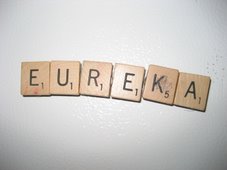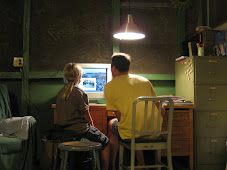We completed an investigation of mass, volume, and mass density. Dad directed the experiment and explained the concepts, and C did the measurements and calculations. In addition to introducing the physical concepts, we also discussed ratios, error, and accuracy.
We measured the mass and volume of small samples of granite gravel, glass marbles, aluminum, steel, alkaline batteries, and a candle. We measured masses using a triple beam balance. We measured volume with a graduated cylinder filled with water by putting each sample in the water and measuring how high the water rose. We found the density of the materials by dividing the mass by the volume.


We don't know why blogger puts this big space here. Go figure.
| Sample | mass(g) | volume(ml) | mass density(g/cc) |
| rock 1 | 13.2 | 5 | 2.64 |
| rock 2 | 10.1 | 4 | 2.53 |
| rock 3 | 10.0 | 4 | 2.5 |
| marble 1 | 19.0 | 8 | 2.4 |
| marble 2 | 5.4 | 2 | 2.7 |
| X-acto handle 1 | 13.4 | 5 | 2.68 |
| X-acto handle 2 | 23.7 | 9 | 2.63 |
| socket adapter | 70.6 | 9 | 7.84 |
| bolt | 38.4 | 5 | 7.68 |
| c battery | 69.5 | 22 | 3.16 |
| aa battery | 24.3 | 8 | 3.04 |
| candle | 8.5 | 10 | .85 |
When making our measurements we had to use a small wad of poster goo to keep the marbles from rolling off the balance. The mass of the goo was too small to measure. We used a skewer to knock air bubbles off of the X-acto handles and shook the bolt in the graduated cylinder. We pushed the candle down into the water with the skewer because it floated.
We looked up standard values for the materials on the web. For granite and steel we found average values because those materials are mixtures. Our measured values agreed with the average values. For aluminum (the X-acto knife handles) the standard is 2.7 g/cc. For paraffin wax the density is 0.93 g/cc.
We wanted to compare our measurements with the standards for paraffin and aluminum, so we calculated the percentage of error:
% error = ((measured value - standard value)/standard value) x 100
For aluminum our percentage of error was 0.7% for the first sample and 3% for the second sample. The measurements for aluminum seemed pretty accurate. For paraffin our percentage of error was 9%. A possible source of this error might be our use of the skewer to push the candle into the water. Another possible problem might be that the candle wasn't pure paraffin.
C enjoyed this experiment, but now is very excited to run out of the room and go play with friends.


